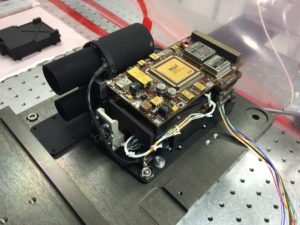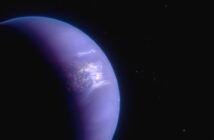Open University (OU) scientists, as part of an international team, have identified a never-before-seen, green glow surrounding Mars with the same characteristics as the Aurora Borealis, also known as the Northern Lights.
Using the NOMAD-UVIS instrument onboard the ExoMars Trace Gas Orbiter (TGO), a joint space mission between the European Space Agency (ESA) and Roscosmos, scientists were able to detect an atmospheric green glow of oxygen surrounding the red planet.
Dr Manish Patel, Senior Lecturer in Planetary Sciences, and Dr Jon Mason, Senior Spaceflight Project Officer at the OU, are co-authors on a paper detailing the research findings and co-lead the team responsible for the instrument that made the discovery.
High-resolution spectrometer makes novel discovery

The UVIS channel of the NOMAD spectrometer
NOMAD consists of a suite of high-resolution spectrometers, including the ultraviolet and visible spectrometer (UVIS) which is operated from The Open University.
A world-first, the green dayglow, a natural “glowing” of our atmosphere, has never been observed in the atmospheres of other planets until now. This is because the surface of the planet is too bright relative to the atmospheric emission, or earlier missions to the planets were not equipped with instruments sensitive to visible light.
NOMAD-UVIS was able to measure the intensity of the green line, around Mars, at the same time as measuring an ultraviolet (UV) oxygen emission.
Previously, scientists have only been able to measure each of these lines separately in the atmosphere of Earth, and the ratio of the line intensity never matched the quantum mechanical prediction.
NOMAD-UVIS is the first instrument to ever observe both lines using the same instrument at the same time – thus removing any calibration errors and settling once and for all the debate between theory and observation.

Dr Manish Patel, Senior Lecturer in Planetary Sciences at The Open University
Dr Manish Patel, co-principal investigator of the NOMAD-UVIS and Senior Lecturer at The Open University, said:
“The UVIS channel of NOMAD continues to return excellent science – we didn’t design the instrument to make these measurements and it’s a fantastic example of the unforeseen additional science you can get from this kind of mission. As a physicist, it is great to see UVIS resolving a long-standing debate between quantum mechanical calculations and remote observations.”
ExoMars Trace Gas Orbiter mission
The ExoMars Trace Gas Orbiter arrived in Mars in October 2016 and spent more than one year using the aerobraking technique needed to reach science orbit, 400 km above the surface of Mars. The spacecraft has been taking science measurements since May 2018.
The primary aim of the mission is to characterise the trace gases in the atmosphere of Mars and investigate surface and sub-surface sources that could be linked to the atmosphere.
The NOMAD experiment is led by the Royal Belgian Institute for Space Aeronomy (IASB-BIRA) and co-led by The Open University (UK), Institute of Astrophysics of Andalusia (IAA-CSIC) in Spain and the National Institute for Astrophysics (INAF-IAPS) in Italy. UK involvement in the mission has been funded by the UK Space Agency.
For more on the research findings on NOMAD-UVIS, read the paper published in Nature Astronomy.



